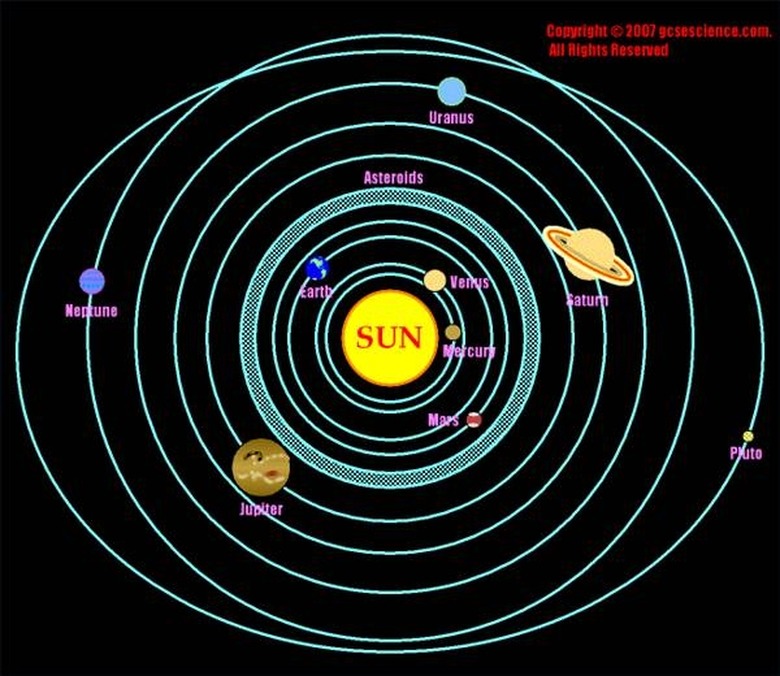What Does The Solar System Look Like?
Our solar system is composed of planets, comets and asteroids along with other space debris that orbits the star we call the sun. Formed more than 4 1/2 billion years ago, our solar system is one of countless like it throughout space. The solar system has fascinated astronomers for centuries. Here's an idea what it looks like, along with a few facts about it.
Theories/Speculation
Theories/Speculation
All of the objects that comprise the solar system originated, scientists theorize, from a huge cloud of gases and dust called a nebula. This cloud began to spin slowly and then faster, with the matter in the center spinning and collapsing in on itself. This became the sun. Other pockets of matter spun off from this cloud and became the planets. Some planets were large enough to use their gravitational forces to attract large amounts of gases. These became the giant planets that include Jupiter, Saturn, Uranus and Neptune. These bodies rotated around the central sun in orbits, thus becoming the solar system.
Features
Features
If you could be above the solar system looking down, you would see the gigantic sun at its center. The sun makes up almost all of the matter in the solar system percentagewise–more than 99 percent. The planets would be orbiting the sun counterclockwise, with Mercury closest to the sun and dwarf planets such as Pluto farthest out. Earth would be the third planet from the Sun, with Venus the second. Mars would be fourth with a belt of space debris called asteroids next, perhaps as many as millions of them ranging in size from hundreds of miles across to microscopic bits. The giant planets Jupiter, Saturn, Uranus and Neptune would follow in that order, with the dwarf planets beyond them.
Time Frame
Time Frame
The planets would be at different stages of their orbits around the sun and not all neatly lined up. Mercury takes only 88 Earth days to complete one march around the Sun. Earth takes a year while Jupiter takes more than 12 years to finish one orbit. The farther out the planet is from the sun, the longer it takes to complete one revolution around it. Neptune, for example, takes 165 Earth years to finish the job.
Types
Types
The inner four planets are much smaller than the outer four. These planets have dense, rocky cores, and only Earth and Mars have moons orbiting them. The outer planets have gaseous make-ups, mostly helium and hydrogen and ice. They have many moons in orbit around them, as their gravitational fields are stronger than the inner planets. The outer planets make up 99 percent of the mass in the solar system, not including the sun. Some of these planets, Saturn for one, have rings spinning around them composed of fine particles.
Considerations
Considerations
While the orbits of the planets are more or less circular to elliptical around the sun, the comets, chunks of rock and ice that were left over from the formation of the solar system have oval shaped orbits that can bring them close to the sun and then take them far away into space. Some comets can approach the sun and then swing past it and return into space to a point well beyond Pluto, taking thousands of years to complete the journey.
Cite This Article
MLA
Lindell, John. "What Does The Solar System Look Like?" sciencing.com, https://www.sciencing.com/does-solar-system-look-like-4585988/. 24 April 2017.
APA
Lindell, John. (2017, April 24). What Does The Solar System Look Like?. sciencing.com. Retrieved from https://www.sciencing.com/does-solar-system-look-like-4585988/
Chicago
Lindell, John. What Does The Solar System Look Like? last modified August 30, 2022. https://www.sciencing.com/does-solar-system-look-like-4585988/
